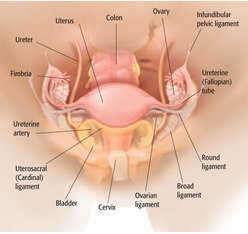HysterectomyA hysterectomy is the surgical removal of the uterus, usually performed by a gynecologist. Hysterectomy may be total (removing the body, fundus, and cervix of the uterus; often called "complete") or partial (removal of the uterine body while leaving the cervix intact; also called "supracervical"). It is the most commonly performed gynecological surgical procedure. In 2003, over 600,000 hysterectomies were performed in the United States alone, of which over 90% were performed for benign conditions. Removal of the uterus renders the patient unable to bear children (as does removal of ovaries and fallopian tubes), and changes the hormonal levels of the female considerably, so the surgery is normally recommended for only a few specific circumstances. 
Although hysterectomy is frequently performed for fibroids (benign tumor-like growths inside the uterus itself made up of muscle and connective tissue), conservative options in treatment are available by doctors who are trained and skilled at alternatives. It is well documented in medical literature that myomectomy, surgical removal of fibroids with reconstruction of the uterus, has been performed for over a century. The uterus is a hormone-responsive reproductive sex organ, and the ovaries produce the majority of estrogen and progesterone that is available in genetic females of reproductive age. Some women's health education groups such as the Hysterectomy Educational Resources and Services (HERS) Foundation seek to inform the public about the many consequences and alternatives to hysterectomy, and the important functions that the female organs have all throughout . |

+91 - 95661 39630
+91 - 94441 68963



